We’re diving back into the world of aroid houseplants with a lovely classic! Let me introduce you to Syngonium podophyllum, better known as the arrowhead plant. Versatile, relatively easy to care for and available in loads of different beautifully colored cultivars, this one is truly hard to resist.
Let’s get into everything you need to know about Syngonium podophyllum and how to grow your own arrowhead plant indoors.
| Common name(s) | Arrowhead plant, Nephthytis*, goosefoot, arrowhead Philodendron, arrowhead vine, African evergreen, American evergreen |
| Scientific name | Syngonium podophyllum |
| Family | Araceae |
| Height and spread | Depends on cultivar; can reach 6 feet in height and 2 feet in width |
| Light | Bright indirect |
| Soil type | Aroid soil |
| Water | Keep lightly moist |
* This is also the name of a totally different African genus of aroids, so to prevent confusion, let’s not use this one.
Disclosure: If you shop from my article or make a purchase through one of my links, I may receive commissions on some of the products I recommend.
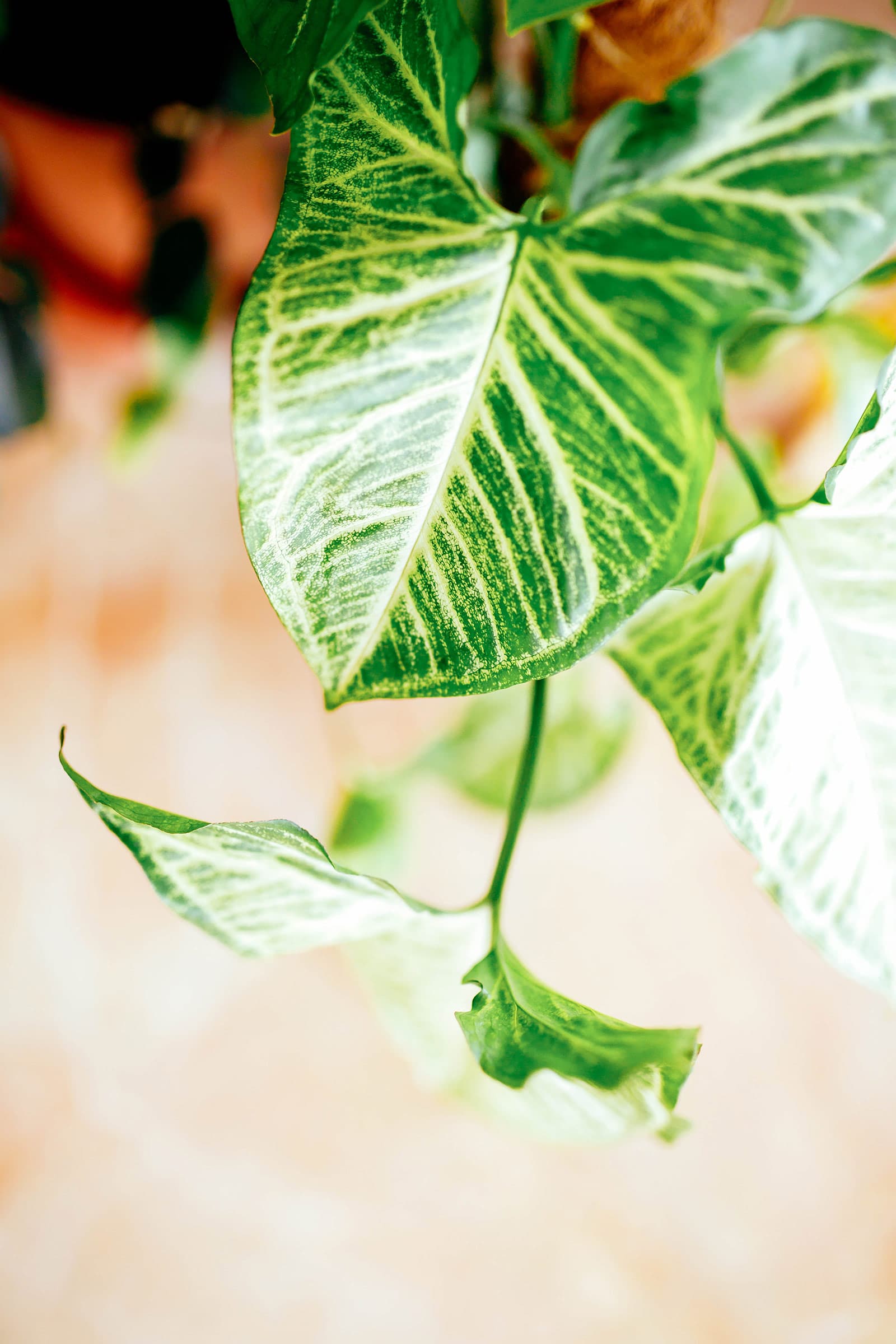
About Syngonium podophyllum
Natural habitat
The arrowhead plant is an evergreen vining plant naturally found in moist tropical regions from Mexico all the way down to Brazil. According to a 1981 review, this makes it the most widespread member of its genus, Syngonium. The species prefers lower-altitude habitats, usually no more than 2,500 feet. As a creeping epiphyte, it vines across the forest floor and up the lower ends of tree trunks, seeking the sun and attaching itself with aerial roots the higher it climbs.
(These clingy aerial roots are typical of other epiphytes, like Swiss cheese plants, mini monsteras, sweetheart Hoyas, flamingo flowers, Christmas cacti, and air plants.)
The tropical forest habitats of the arrowhead plant are characterized by high rainfall with no dry season, high temperatures year-round, and high levels of air humidity. All handy factors to keep in mind if you’re looking to successfully grow an arrowhead plant in your home!
Did you know? Syngonium podophyllum is naturalized in many areas outside its original range. This includes the southern US, Seychelles, Singapore, Hawaii, and various other countries.
Description
As I mentioned, Syngonium podophyllum is a vining plant. You’ll often see it sold as a juvenile with barely any visible stem, but as it grows, more and more stems with air roots will begin to pop up. The plant will start looking for a surface to climb like it would in the wild, and if you don’t provide it with a moss pole, your Syngonium will start to hang downwards and become a trailing plant.
‘Podophyllum’ means ‘with leaves like feet,’ and it’s hard to argue with that, although apparently some folks find them more arrowhead-shaped (hence the common name). Whatever the leaves remind you of, they vary in appearance according to the plant’s age.
Juvenile arrowhead plants sport that typical single-leaved, pointed look, while mature leaves on plants that are allowed to climb are actually multi-lobed. This makes it look like there are multiple leaves on each stem.
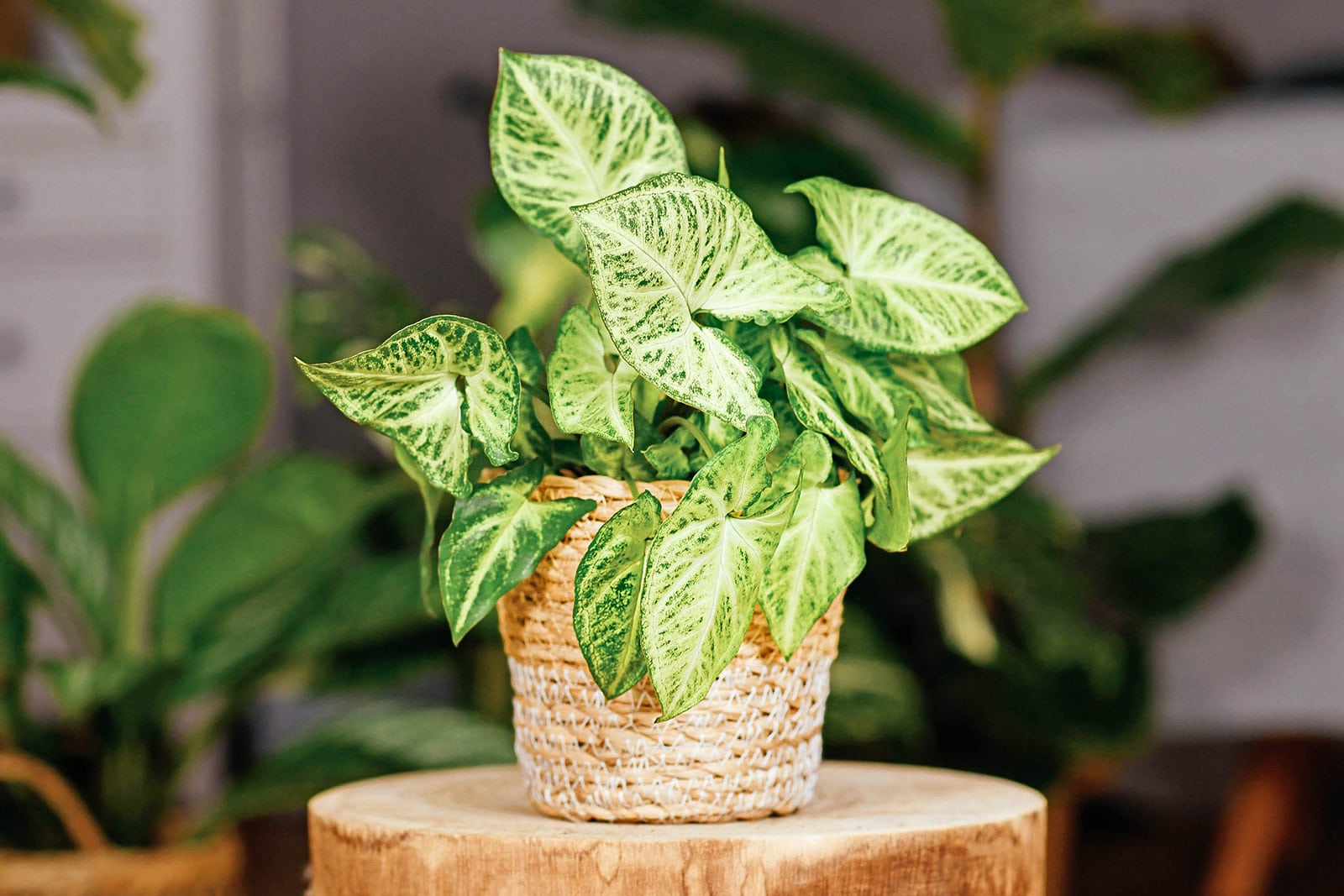
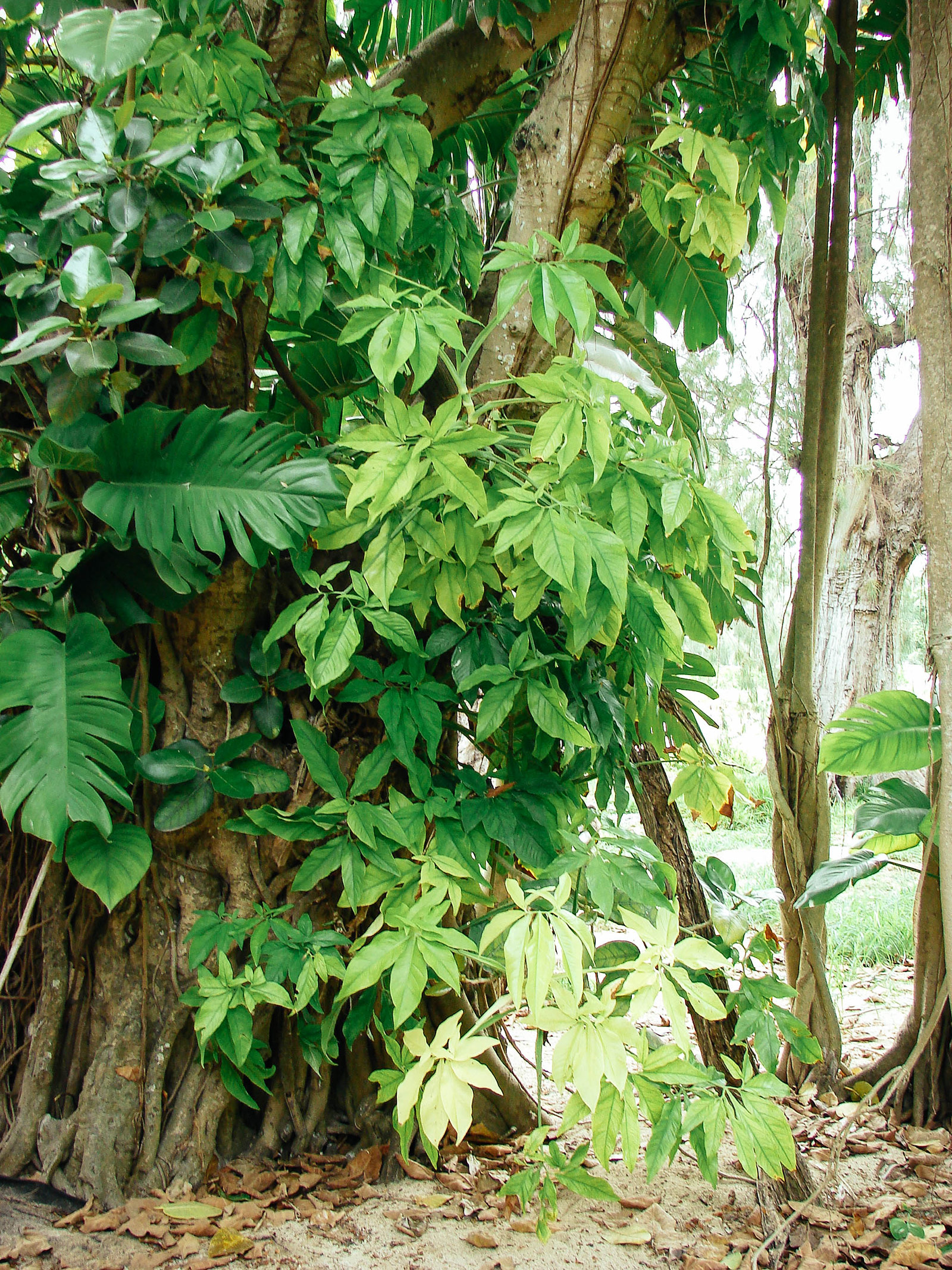
Most houseplant enthusiasts are so used to immature arrowhead plants that they would have trouble recognizing an older specimen! Pretty cool how a plant changes, if you ask me.

Syngonium podophyllum varieties
There are two naturally occurring varieties of arrowhead plant currently recognized: Syngonium podophyllum var. Peliocladum (found in Costa Rica and Panama; Croat, 1981) and Syngonium podophyllum var. Podophyllum (found from Mexico to Brazil). There are plenty of subtle visual differences within the genus, though, depending on where the plant is found.
As for man-made varieties… the “original” arrowhead plant is already a pretty nice species to look at, with green foliage streaked with lighter leaf veins. However, as nurseries discovered, this aroid also lends itself incredibly well for selective cultivation. An array of different-colored cultivars has been created—we’d be here for hours if I tried to discuss them all—and there are also a few that stand out due to their unusual leaf shapes and sizes.
Probably the most extensive is the Allusion Series™ by AgriStarts. This nursery holds a huge range of different arrowhead plant cultivars, which you can view on their Syngonium page.
Here are a few of the most common (but by no means the only) arrowhead plants you may stumble upon at your local plant store or garden center:
- Syngonium ‘White Butterfly’: By far the most common cultivar. Mottled green with very light green veins, this one is really pretty for such a cheap and easy-to-find plant.
- Syngonium ‘Neon Robusta’: Yes, arrowhead plants come in pink! With its papery, muted pink leaves, this one is something to behold. There are many similar cultivars like ‘Regina Red’, ‘Pink Allusion’, ‘Red Heart’, and more Syngoniums that also have pink leaves.
- Syngonium ‘Maria’: The ‘Marias’ are what happens if you mix pink with green. No two leaves are the same, sporting beautiful greens, pinks, bronzes, and browns. There is also ‘Maria Allusion’.
- Syngonium ‘Strawberry Cream’: The leaves on this arrowhead plant emerge as a creamy blush pink, but eventually mellows out to green with pink veining as the plant matures.
- Syngonium ‘Christmas’: This rare cultivar features dark green, minty green, and pink leaves with splashes of darker pink variegation. Some leaves may be darker and others lighter, creating an unusual speckled pattern.
- Syngonium ‘Pixie’: As the name suggests, this one is teeny tiny, which is perfect if you’re looking for a mini Syngonium that doesn’t get too unruly. Its leaves are a mix of dark and light green.
- Syngonium ‘Albo-Variegatum’: If you’ve been an indoor gardener for a while, you know how things go with Albo plants. They’re the “holy grail,” on the expensive side and widely coveted. That’s no different with this green and white variegated Syngonium.
- Syngonium ‘Trileaf Wonder’: A very rare cultivar that sports three leaves on a single stem. The leaves start out light green and develop into a deep glossy green as they mature.
I’d also like to give a little shout-out to my personal favorites, although they’re not very easy to track down: the Confetti line. It consists of Syngonium ‘Confetti’, ‘Confetti Tricolor’, and ‘Milk Confetti’ and is, of course, characterized by its speckled appearance.
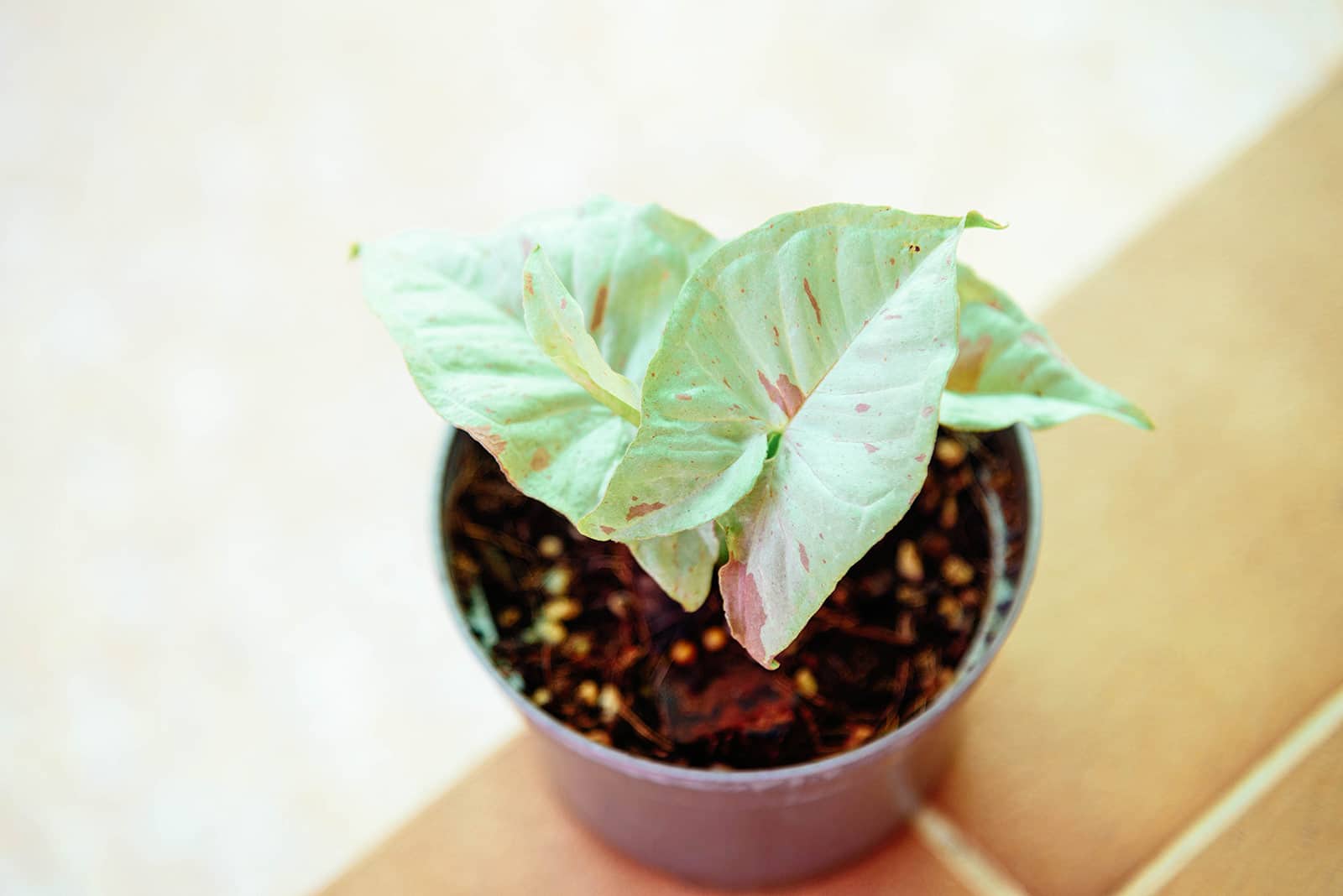
Where to buy Syngonium podophyllum plants:
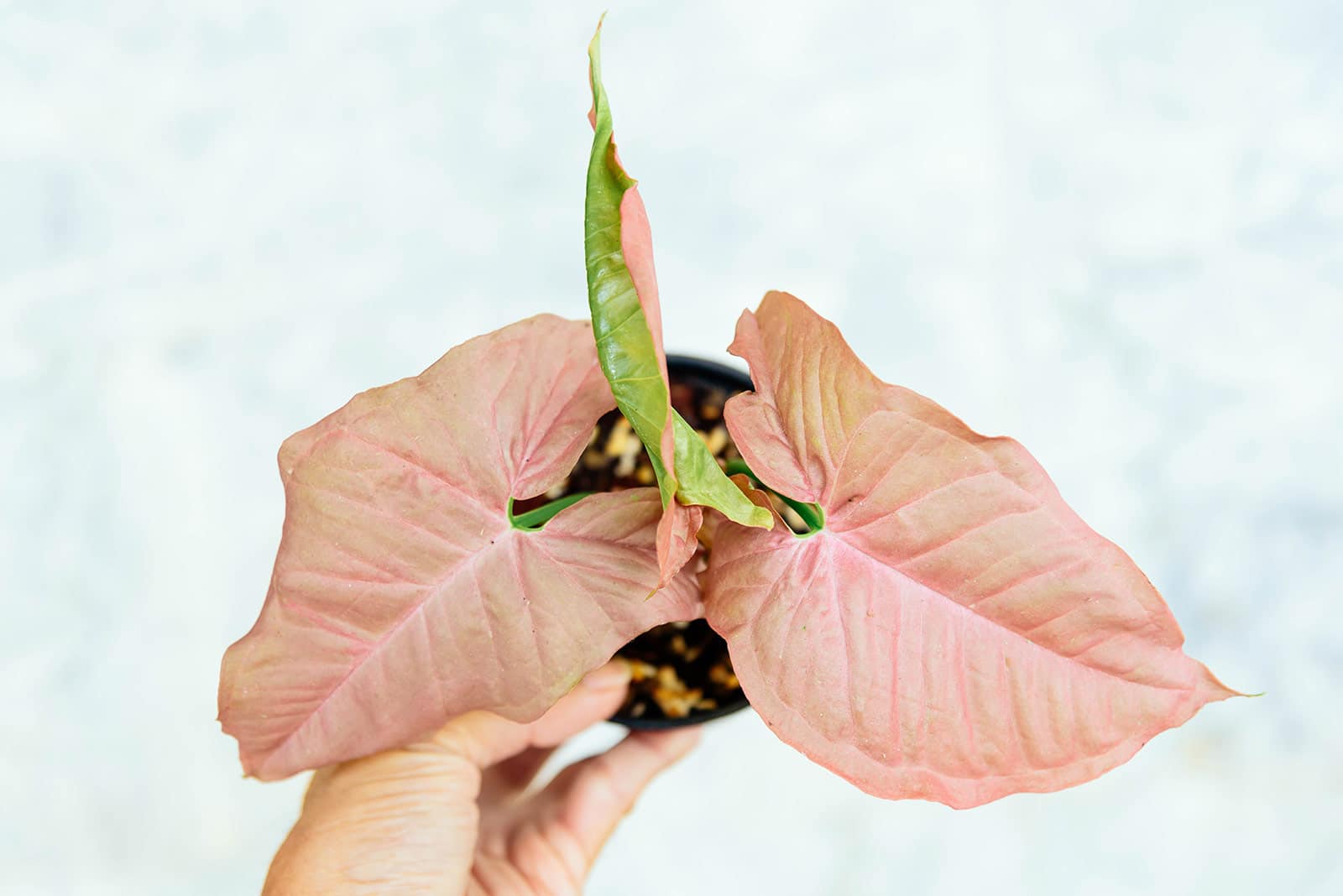
Caring for Syngonium podophyllum
Light and temperature
The arrowhead plant is a relatively low-light species. After all, it naturally forms part of the rainforest undergrowth, meaning it isn’t used to being blasted with sun.
Related: Dark Room? 9 Actual Low-Light Plants That Don’t Need a Lot of Sun
This being said, low light doesn’t mean what many beginning houseplant enthusiasts think it does—your Syngonium podophyllum will still need to be close to a window to thrive.
You unfortunately can’t use it to spruce up a dark corner in your home unless you use artificial lighting. Just don’t place it near a window that receives a lot of direct sun, at least not without careful acclimation.
Temperature-wise, this is a tropical plant, so it doesn’t like the cold. Mine have done well down to 59°F with no harm done, but I probably wouldn’t push my luck any further. High temperatures, on the other hand, are not a problem. Room temp is perfect, but your plant should be able to withstand much warmer without issue as well.
Water and humidity
Although the rainforests this plant naturally grows in are characterized by their very high annual rainfall levels, I’ve found that my arrowhead does better if I avoid being too heavy-handed with the watering can. I keep mine lightly moist during the summer months when they’re actively putting out new foliage; this tends to come down to two waterings a week.
In the dead of winter, you may not have to water your arrowhead plant for up to two weeks. The soil is best left to dry out about halfway. Not sure what the moisture status is? Just go for the ol’ finger trick: If the soil feels just about dry, you can give your Syngonium podophyllum a sip.
Did you know? If you often forget to water your houseplants, you might consider growing Syngonium podophyllum hydroponically. It’s an excellent plant species for growing in water (with none of the mess of potting soil).
In terms of air humidity, this one is on the forgiving side, but it still really doesn’t like things overly dry. You can use an inexpensive digital hygrometer like this one to see where you’re at, especially if your tropical houseplants tend to show dry leaf tips. If the humidity is consistently under 40 percent, you may want to invest in a humidifier or grow your arrowhead plant in a terrarium environment.
Soil and planting
Although the arrowhead plant is an aroid, it doesn’t seem to appreciate very loose aroid mixes like some other members of this family do (Philodendron ‘Pink Princess’ and Alocasia ‘Polly’, for example).
Instead, go for something that’s still well-draining but also rich. A good example would be 50 percent regular houseplant potting soil, 25 percent coco coir, sphagnum moss or peat, and 25 percent perlite. You can also add some worm castings, which is a great fertilizer.
The coir, moss or peat ensures the soil holds some moisture, while the perlite allows the excess to drain easily, preventing root rot due to standing water. Don’t worry if this sounds like a lot of stuff to buy, as all these soil amendments can be used for a wide variety of houseplants. They’re always handy to have on hand.
In terms of planters, consider whether you’d like to leave your Syngonium vining down, or let it climb upwards on a moss pole. The former means a hanging planter may be handy, while for the latter a normal planter is great. You can stake the plant to its moss pole once you see the first signs of stems and air roots popping up.
Did you know? Arrowhead plants are great candidates for growing in water. Not submerged in the aquarium, although you’ll sometimes see them sold for that purpose; the leaves need to stay dry. Instead, pop just the roots in your fish tank (or in a vase, or LECA, whatever you prefer).
Recommended products for Syngonium podophyllum plant care:
- Good Earth Organics Premium Potting Soil
- Burpee Organic Coconut Coir
- Better-Gro Orchid Moss
- Perfect Plants Organic Perlite
- Wiggle Worm Soil Builder Pure Worm Castings
- Totem Monkey Extendable Coir Moss Poles
Fertilizing
Unless you just repotted your arrowhead plant (especially if you added some worm castings), this species will appreciate the occasional feeding during the spring and summer growing seasons. You can mix a balanced liquid houseplant fertilizer (at half-strength) into its water every other week if it’s growing well and producing plenty of new foliage.
Don’t use fertilizer during winter of if your Syngonium podophyllum is unhappy. It won’t trigger new growth and can actually cause damage to the roots.
Recommended fertilizers for Syngonium podophyllum:
- Houseplant Resource Center Liquid Fertilizer for Houseplants
- Instant Biologics Instant Plant Food (Fizzing Nutrient Tablets)
- Maxsea All-Purpose Seaweed Plant Food
Pruning
Your arrowhead plant won’t need to be pruned unless it’s become very unruly and the look is bothering you. You may have to remove the occasional crispy leaf (it’s normal for houseplants to get rid of some of their old foliage), but that’s about it.
Dividing or repotting
I’ve found that in the case of Syngonium podophyllum, dividing won’t usually be necessary. They don’t tend to spread that much in terms of width, focusing much more strongly on upward growth instead.
You can repot every one to two years depending on how well your plant is doing, going up a pot size if the root system has become very large or just refreshing the soil if it hasn’t.

Propagating Syngonium podophyllum
As with almost all aroids, propagating Syngonium podophyllum is a total breeze, especially on more mature plants that have clearly exposed stems. If your plant is still a baby you’ll have to go the division route instead, but that’s not a problem. Most specimens consist of multiple shoots in the same pot, which can easily be separated.
Here’s how dividing an arrowhead plant works:
- Take your Syngonium podophyllum out of its planter and carefully crumble or shake away the soil.
- At this point, different sections may already come loose without any intervention.
- If they’re firmly attached, use a clean knife to cut through the root ball and stem connections. Make sure each section has some roots of its own.
- Pot each section into some fresh arrowhead plant soil and you’re done!
Got a plant with visible stems? Perfect! You can still divide, but if you prefer, you can also take cuttings:
- Use clean pruning shears to behead your arrowhead plant. No worries, the headless stem will regrow from a different growth point.
- Propagate in water by placing the cutting in a vase, submerged about one-third of the way. Set the whole thing in a bright location and wait until roots sprout (it can be a few weeks or months). Then, pot the plant—or don’t!
- Propagate in soil by sticking the cutting in a planter with Syngonium soil, placing it in a bright location and keeping it lightly moist. Dipping in rooting powder before planting can be helpful. You’ll know you’re in the clear once you see the first new leaves popping up.
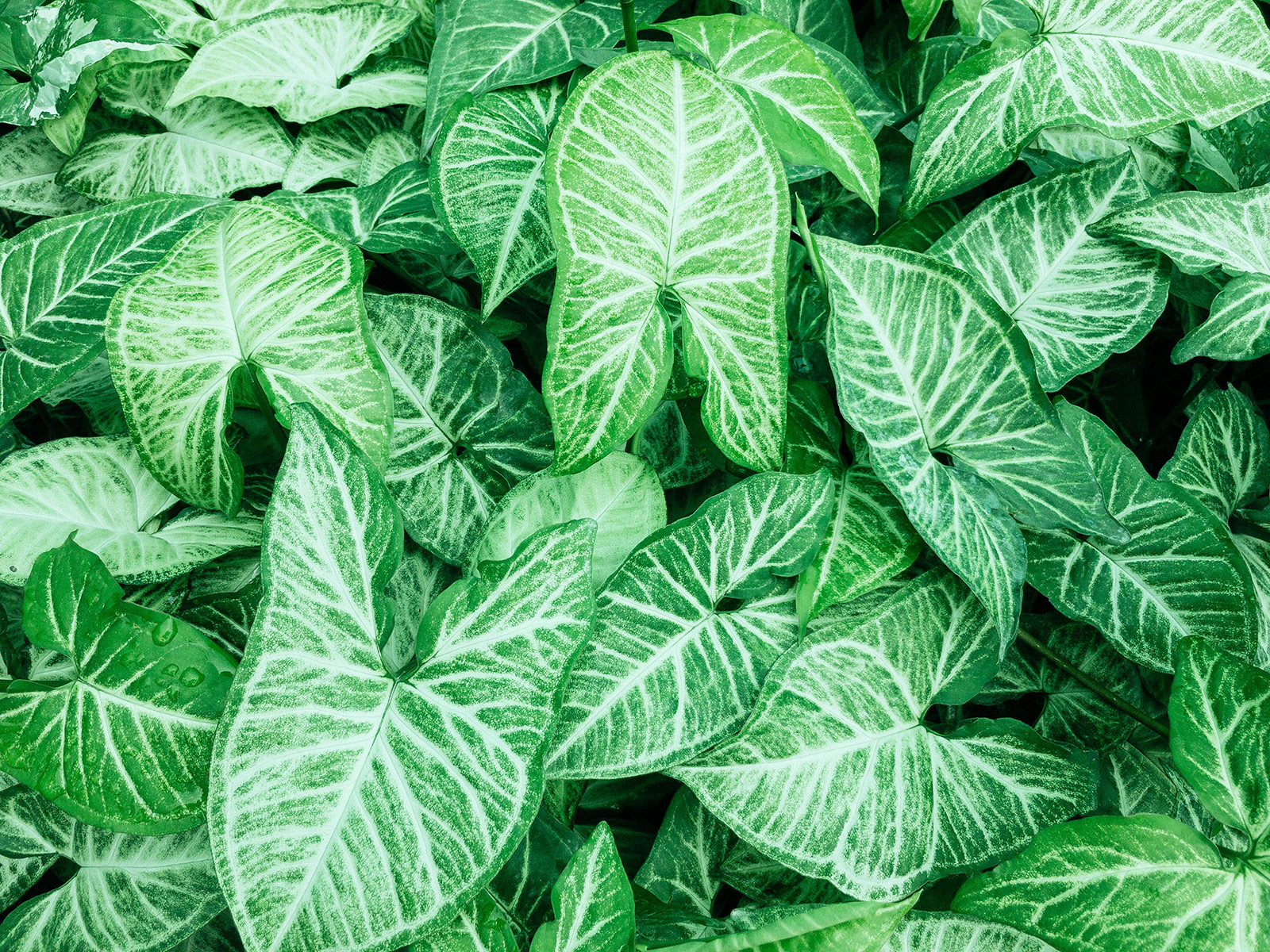
Common questions about Syngonium podophyllum care
Do arrowhead plants like to be root bound?
Syngonium podophyllum does not like to be root bound, so every one to two years, repot your arrowhead plant in a pot that’s one size up, or divide the plant and pot up individual sections if you prefer smaller plants.
Do arrowhead plants need support?
Syngonium podophyllum is an evergreen climbing plant, and will begin to vine as it ages. You can train the vines up a moss pole, trellis, or some other support, or let it naturally cascade down a hanging basket.
Is Syngonium podophyllum toxic to cats and dogs?
Aroids like the arrowhead plant are considered “toxic,” but their toxicity does tend to be overstated. Their sap is rich in calcium oxalate crystals which cause a burning sensation in the mouth. That being said, taking a bite out of a Syngonium is highly unlikely to cause more than some pain and swelling.
Offer water and hope they’ve learned their lesson; sometimes it’s necessary to move the plant out of the way if your furry friend is a repeat offender.
Sources:
https://wcsp.science.kew.org/furtherInformation.do?name_id=199060
Chong, K. Y., Ang, P. T., & Tan, H. T. W. (2010). Identity and spread of an exotic Syngonium species in Singapore. Nature in Singapore, 3, 1-5.
Croat, T. B. (1981). A revision of Syngonium (Araceae). Annals of the Missouri Botanical Garden, 565-651.
Matyot, P. (1999). The arrowhead vine, Syngonium podophyllum Schott (Family Araceae), a potential invader in Seychelles. Phelsuma, 7, 72-73.
















Hi Linda
Thank you for this very informative post firstly. I consider myself very new to the world of indoor plants, having purchased my first one at a market probably less than 12 months ago. I am trying my hardest to soak up as much knowledge about the do’s and don’t and likes and dislikes of the 8 different plants I currently have before investing time, energy and funds into any extras.
I have a beautiful green and white variegated one of these gorgeous plants, and it’s the first houseplant I ever purchased. It’s little tag referred to it as a white fantasy. I completely blame my newly developed obsession on its delicate form and sheer beauty.
I repotted it last weekend and accidentally broke off a long piece at least a metre long, it was a sad moment, but it’s not gone to waste and is now being encouraged to grow roots in a glass of water.
I’m wondering if you know anything about what causes the leaves with halves of white to go floppy and significantly thinner than the other half that is a mix of green and white? I don’t know if it’s a normal thing for these portions of leaf that are lacking chlorophyll or if it signals a problem of some kind? I can’t seem to find any information about it anywhere!
Thanks for sharing your knowledge. I read a quote the other day from I can’t remember who, but it said something along the lines of ‘knowledge is the one thing we posses that can be simultaneously shared and retained.’ Hopefully I didn’t completely butcher the quote trying to recall it, but I just love the vibes it gives.
Stay well and happy.